Modal Variability of Ginkgo Seed–Stem System Based on Model Updating
Abstract
:1. Introduction
2. Material and Methods
2.1. Raw Material and Sample Preparation
2.2. Model Updating Process
2.2.1. Physical Tensile Test
2.2.2. Free Oscillation Test
2.2.3. Establishment of the Simulation Model
2.3. Modal Variability Identification
3. Results and Discussion
4. Conclusions
Author Contributions
Funding
Data Availability Statement
Acknowledgments
Conflicts of Interest
References
- Boateng, I.D.; Yang, X.M. Do non-thermal pretreatments followed by intermediate-wave infrared drying affect toxicity, allergenicity, bioactives, functional groups, and flavor components of Ginkgo biloba seed? A case study. Ind. Crops Prod. 2021, 165, 113421. [Google Scholar] [CrossRef]
- Feng, L.; Sun, J.; El-Kassaby, Y.A.; Luo, D.; Guo, J.; He, X.; Zhao, G.; Tian, X.; Qiu, J.; Feng, Z.; et al. Planning Ginkgo biloba future fruit production areas under climate change: Application of a combinatorial modeling approach. For. Ecol. Manag. 2023, 533, 120861. [Google Scholar] [CrossRef]
- Guo, Y.; Wang, M.; Gao, C.; Fu, F.F.; El-Kassaby, Y.A.; Wang, T.; Wang, G. Spatial prediction and delineation of Ginkgo biloba production areas under current and future climatic conditions. Ind. Crops Prod. 2021, 166, 113444. [Google Scholar] [CrossRef]
- Zhou, J.; Xu, L.; Xuan, Y.; Xu, Y.; Liu, G. Shedding frequency and motion of jujube fruits in various excitation modes. Trans. ASABE 2020, 63, 881–889. [Google Scholar] [CrossRef]
- Castro-Garcia, S.; Blanco-Roldán, G.L.; Ferguson, L.; González-Sánchez, E.J.; Gil-Ribes, J.A. Frequency response of late-season ‘Valencia’orange to selective harvesting by vibration for juice industry. Biosyst. Eng. 2017, 155, 77–83. [Google Scholar] [CrossRef]
- He, L.; Zhou, J.; Du, X.; Chen, D.; Zhang, Q.; Karkee, M. Energy efficacy analysis of a mechanical shaker in sweet cherry harvesting. Biosyst. Eng. 2013, 116, 309–315. [Google Scholar] [CrossRef]
- He, L.; Fu, H.; Karkee, M.; Zhang, Q. Effect of fruit location on apple detachment with mechanical shaking. Biosyst. Eng. 2017, 157, 63–71. [Google Scholar] [CrossRef]
- Maja, J.; Ehsani, R. Development of a yield monitoring system for citrus mechanical harvesting machines. Precis. Agric. 2010, 11, 475–487. [Google Scholar] [CrossRef]
- Zhou, J.; Xu, L.; Liu, G.; Xuan, Y.; Zhou, H.; Jiang, H. Frequency response curves and dynamic characteristics of a ginkgo tree in different growth periods. Trans. ASABE 2020, 63, 1673–1684. [Google Scholar] [CrossRef]
- Hoshyarmanesh, H.; Dastgerdi, H.R.; Ghodsi, M.; Khandan, R.; Zareinia, K. Numerical and experimental vibration analysis of olive tree for optimal mechanized harvesting efficiency and productivity. Comput. Electron. Agric. 2017, 132, 34–48. [Google Scholar] [CrossRef]
- Du, X.; Chen, D.; Zhang, Q.; Scharf, P.A.; Whiting, M.D. Dynamic responses of sweet cherry trees under vibratory excitations. Biosyst. Eng. 2012, 111, 305–314. [Google Scholar] [CrossRef]
- Velloso, N.S.; Magalhães, R.R.; Santos, F.L.; Santos, A.A. Modal properties of coffee plants via numerical simulation. Comput. Electron. Agric. 2020, 175, 105552. [Google Scholar] [CrossRef]
- Zhou, H.; Zhang, J.; Ge, L.; Yu, X.; Wang, Y.; Zhang, C. Research on volume prediction of single tree canopy based on three-dimensional (3D) LiDAR and clustering segmentation. Int. J. Remote Sens. 2021, 42, 738–755. [Google Scholar] [CrossRef]
- Kazama, E.; da Silva, R.; Tavares, T.; Correa, L.; Estevam, F.; Nicolau, F.; Maldonado, W. Methodology for selective coffee harvesting in management zones of yield and maturation. Precis. Agric. 2021, 22, 711–733. [Google Scholar] [CrossRef]
- Santos, F.L.; Scinocca, F.; de Siqueira Marques, D.; Velloso, N.S.; de Melo Villar, F.M. Modal properties of macaw palm fruit-rachilla system: An approach by the stochastic finite element method (SFEM). Comput. Electron. Agric. 2021, 184, 106099. [Google Scholar] [CrossRef]
- Tinoco, H.A.; Peña, F.M. Harmonic stress analysis on Coffea arábica L. var. Colombia fruits in order to stimulate the selective detachment: A finite element analysis. Simulation 2018, 94, 163–174. [Google Scholar] [CrossRef]
- Bu, L.; Chen, C.; Hu, G.; Zhou, J.; Sugirbay, A.; Chen, J. Investigating the dynamic behavior of an apple branch-stem-fruit model using experimental and simulation analysis. Comput. Electron. Agric. 2021, 186, 106224. [Google Scholar] [CrossRef]
- Tinoco, H.A.; Ocampo, D.A.; Peña, F.M.; Sanz-Uribe, J.R. Finite element modal analysis of the fruit-peduncle of Coffea arabica L. var. Colombia estimating its geometrical and mechanical properties. Comput. Electron. Agric. 2014, 108, 17–27. [Google Scholar] [CrossRef]
- Bu, L.; Hu, G.; Chen, C.; Sugirbay, A.; Chen, J. Experimental and simulation analysis of optimum picking patterns for robotic apple harvesting. Sci. Hortic. 2020, 261, 108937. [Google Scholar] [CrossRef]
- Yang, L.; Yang, M.; Yang, G. Modeling fractures and cracks on tree branches. Comput. Graph. 2019, 80, 63–72. [Google Scholar] [CrossRef]
- Liu, J.; Yuan, Y.; Gao, Y.; Tang, S.; Li, Z. Virtual model of grip-and-cut picking for simulation of vibration and falling of grape clusters. Trans. ASABE 2019, 62, 603–614. [Google Scholar] [CrossRef]
- Villibor, G.P.; Santos, F.L.; de Queiroz, D.M.; Junior, J.K.; de Carvalho Pinto, F.D. Dynamic behavior of coffee fruit-stem system using modeling of flexible bodies. Comput. Electron. Agric. 2019, 166, 105009. [Google Scholar] [CrossRef]
- Pereira, L.M.S.; Milan, T.M.; Tapia-Blácido, D.R. Using response surface methodology (RSM) to optimize 2G bioethanol production: A review. Biomass Bioenergy 2021, 151, 106166. [Google Scholar] [CrossRef]
- Wang, Y.; Zhang, Y.; Yang, Y.; Zhao, H.; Yang, C.; He, Y.; Wang, K.; Liu, D.; Xu, H. Discrete element modelling of citrus fruit stalks and its verification. Biosyst. Eng. 2020, 200, 400–414. [Google Scholar] [CrossRef]
- Yolmeh, M.; Jafari, S.M. Applications of response surface methodology in the food industry processes. Food Bioprocess Technol. 2017, 10, 413–433. [Google Scholar] [CrossRef]
- Meggitt, J.W.R.; Moorhouse, A.T. Finite element model updating using in-situ experimental data. J. Sound Vib. 2020, 489, 115675. [Google Scholar] [CrossRef]
- Jiang, D.; Nie, W.; Fei, Q.; Wu, S. Free vibration analysis of composite panels considering correlations of spatially distributed uncertain parameters. Appl. Math. Model. 2021, 98, 747–757. [Google Scholar] [CrossRef]
- Aloisio, A.; Alaggio, R.; Fragiacomo, M. Dynamic identification and model updating of full-scale concrete box girders based on the experimental torsional response. Constr. Build. Mater. 2020, 264, 120146. [Google Scholar] [CrossRef]
- Aloisio, A.; Pasca, D.P.; Alaggio, R.; Fragiacomo, M. Bayesian estimate of the elastic modulus of concrete box girders from dynamic identification: A statistical framework for the A24 motorway in Italy. Struct. Infrastruct. Eng. 2021, 17, 1626–1638. [Google Scholar] [CrossRef]
- Qian, H.; Wu, Y.; Zhu, R.; Zhang, D.; Jiang, D. Modal identification of ultralow-frequency flexible structures based on digital image correlation method. Appl. Sci. 2022, 12, 185. [Google Scholar] [CrossRef]
- Aragon-Rodriguez, F.; Castro-Garcia, S.; Sola-Guirado, R.R.; Gil-Ribes, J.A. Fruit abscission pattern of ‘Valencia’ orange with canopy shaker system. Sci. Hortic. 2019, 246, 916–920. [Google Scholar] [CrossRef]
- Wang, Y.; Wang, W.; Fu, H.; Yang, Z.; Lu, H. Detachment patterns and impact characteristics of litchi fruit during vibrational harvesting. Sci. Hortic. 2022, 295, 110836. [Google Scholar] [CrossRef]
- Peterson, D.L. Harvest mechanization progress and prospects for fresh market quality deciduous tree fruits. HortTechnology 2005, 15, 72–75. [Google Scholar] [CrossRef]
- Zhou, H.; Wang, X.; Au, W.; Kang, H.; Chen, C. Intelligent robots for fruit harvesting: Recent developments and future challenges. Precis. Agric. 2022, 23, 1856–1907. [Google Scholar] [CrossRef]
- Zhou, J.; Xu, L.; Zhao, J.; Hang, X.; Zhou, H. Effective excitation conditions for the intense motion of the ginkgo seed-stem system during mechanical vibration harvesting. Biosyst. Eng. 2022, 215, 239–248. [Google Scholar] [CrossRef]
- Crooke, J.R.; Rand, R.H. Vibratory fruit harvesting: A linear theory of fruit-stem dynamics. J. Agric. Eng. Res. 1969, 14, 195–209. [Google Scholar] [CrossRef]
- Parchomchuk, P.; Cooke, J.R. Vibratory harvesting: An experimental analysis of fruit-stem dynamics. Trans. ASAE 1972, 15, 598–603. [Google Scholar]


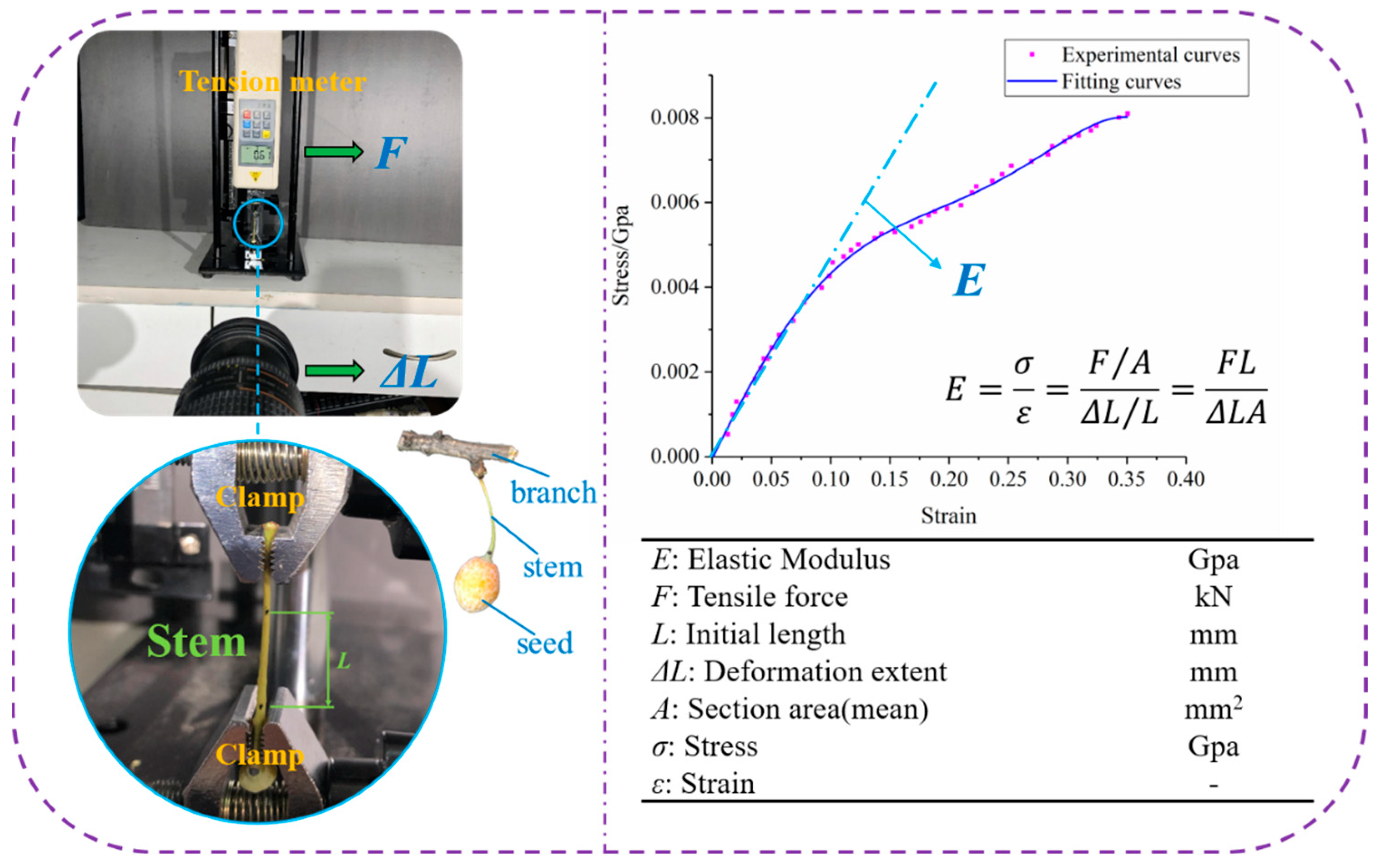
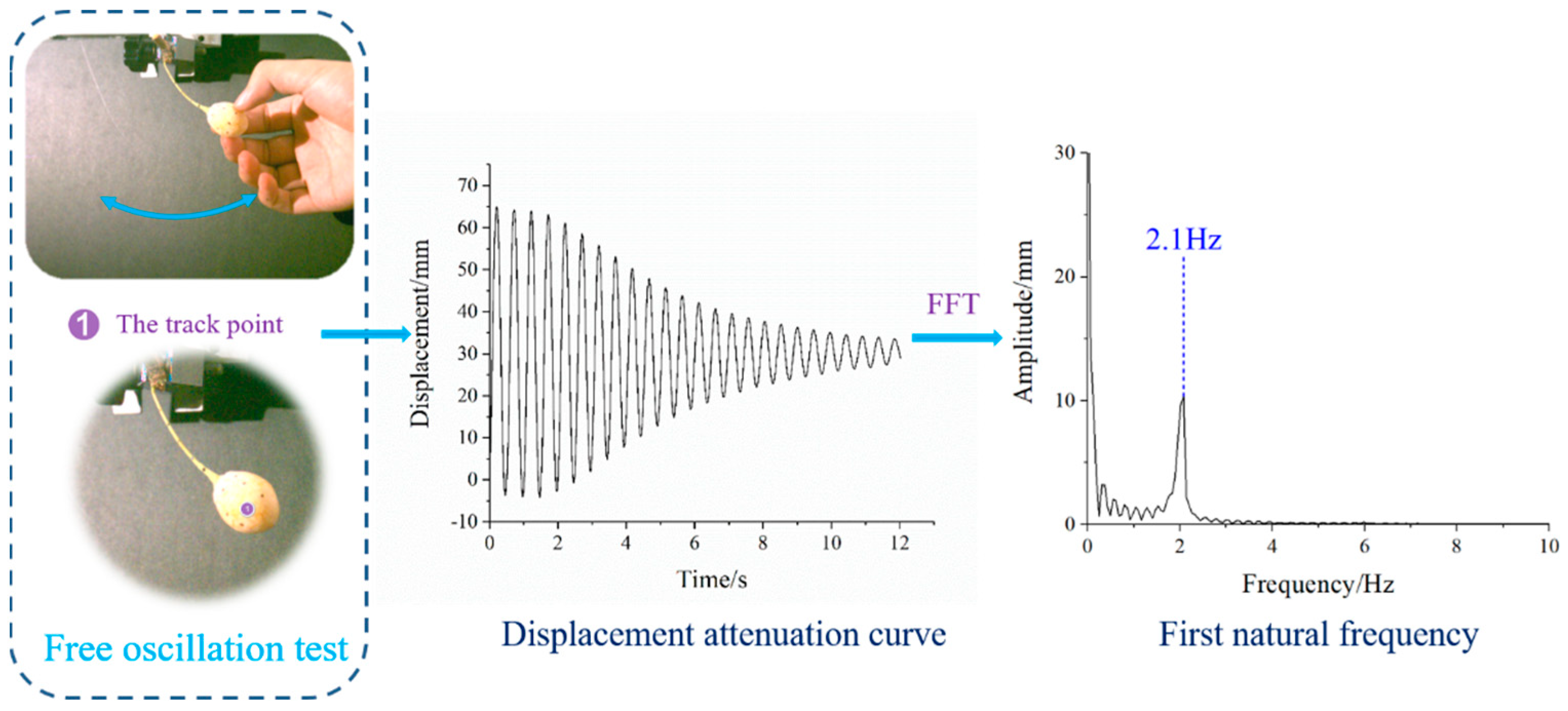


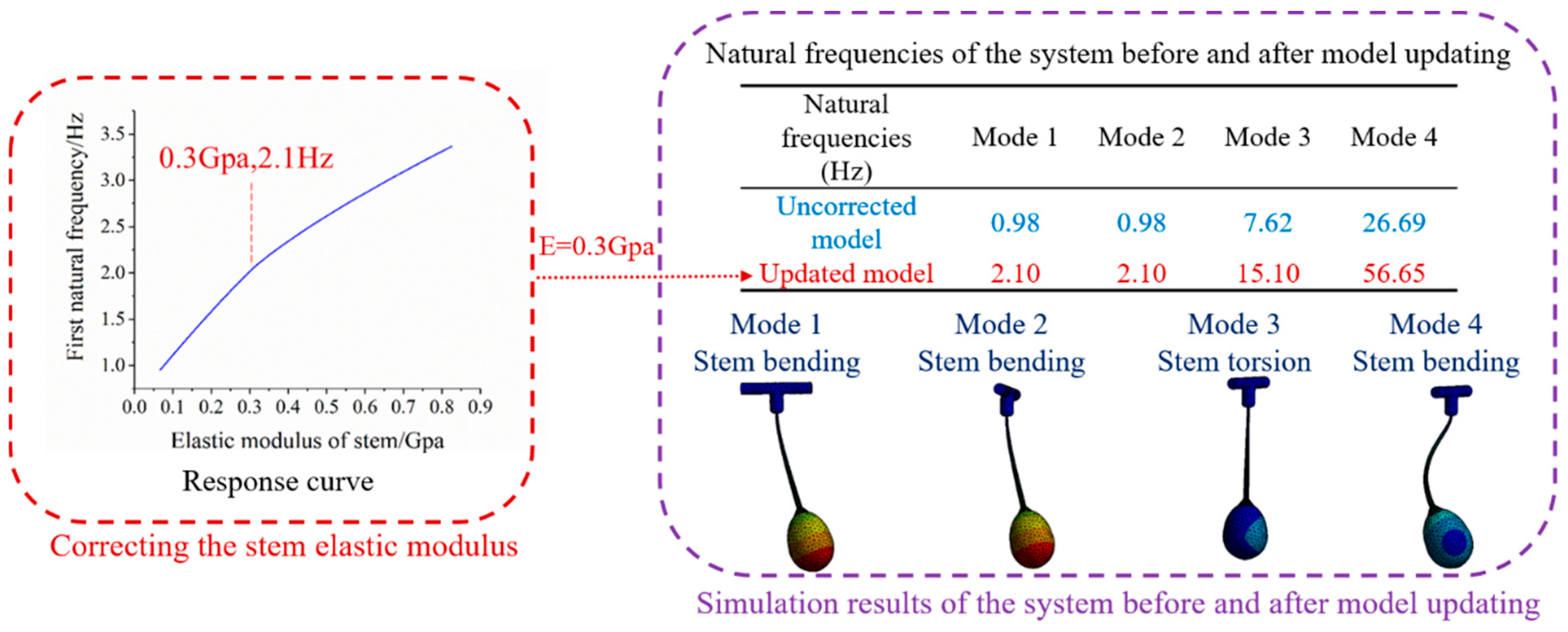

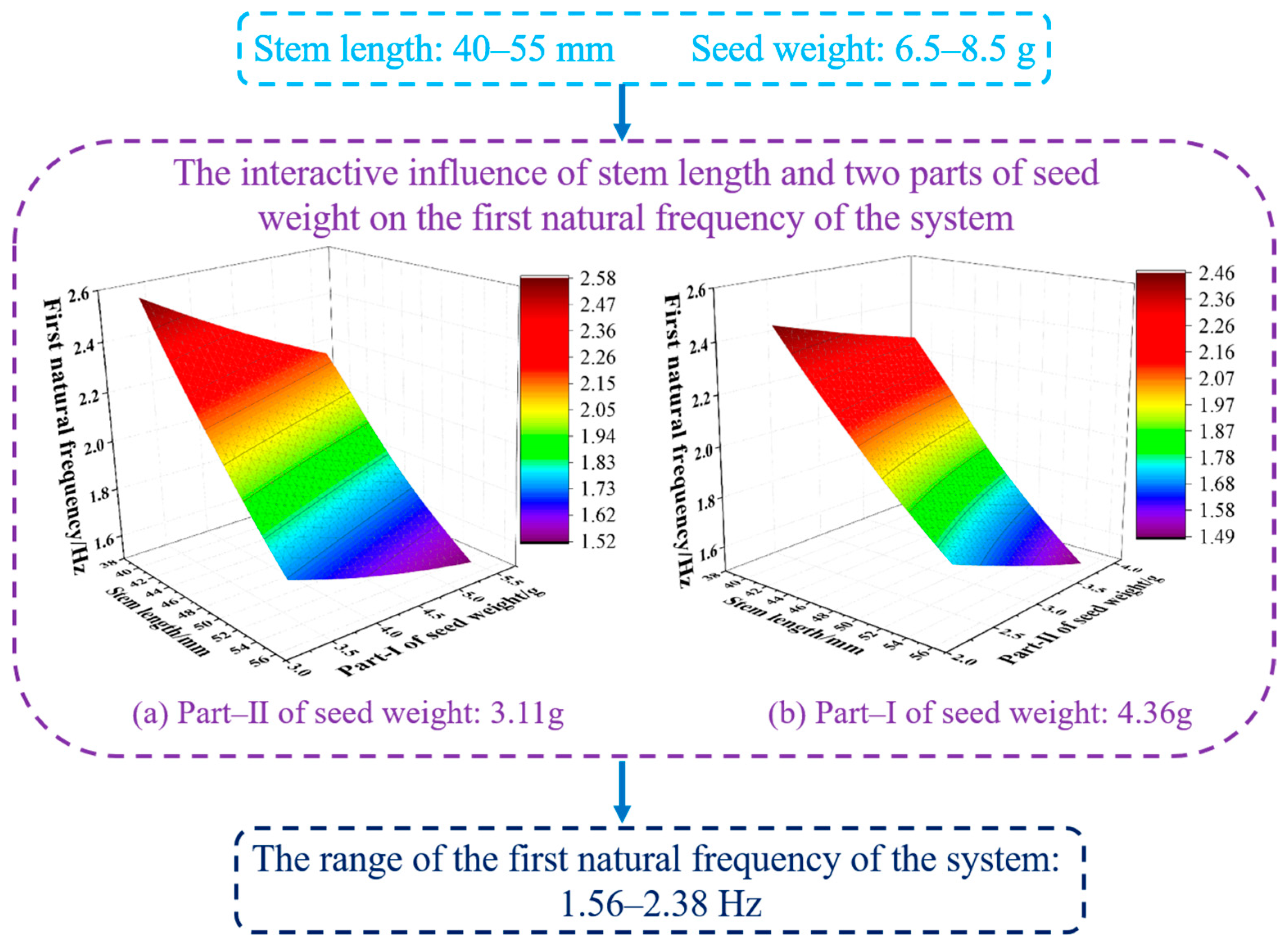
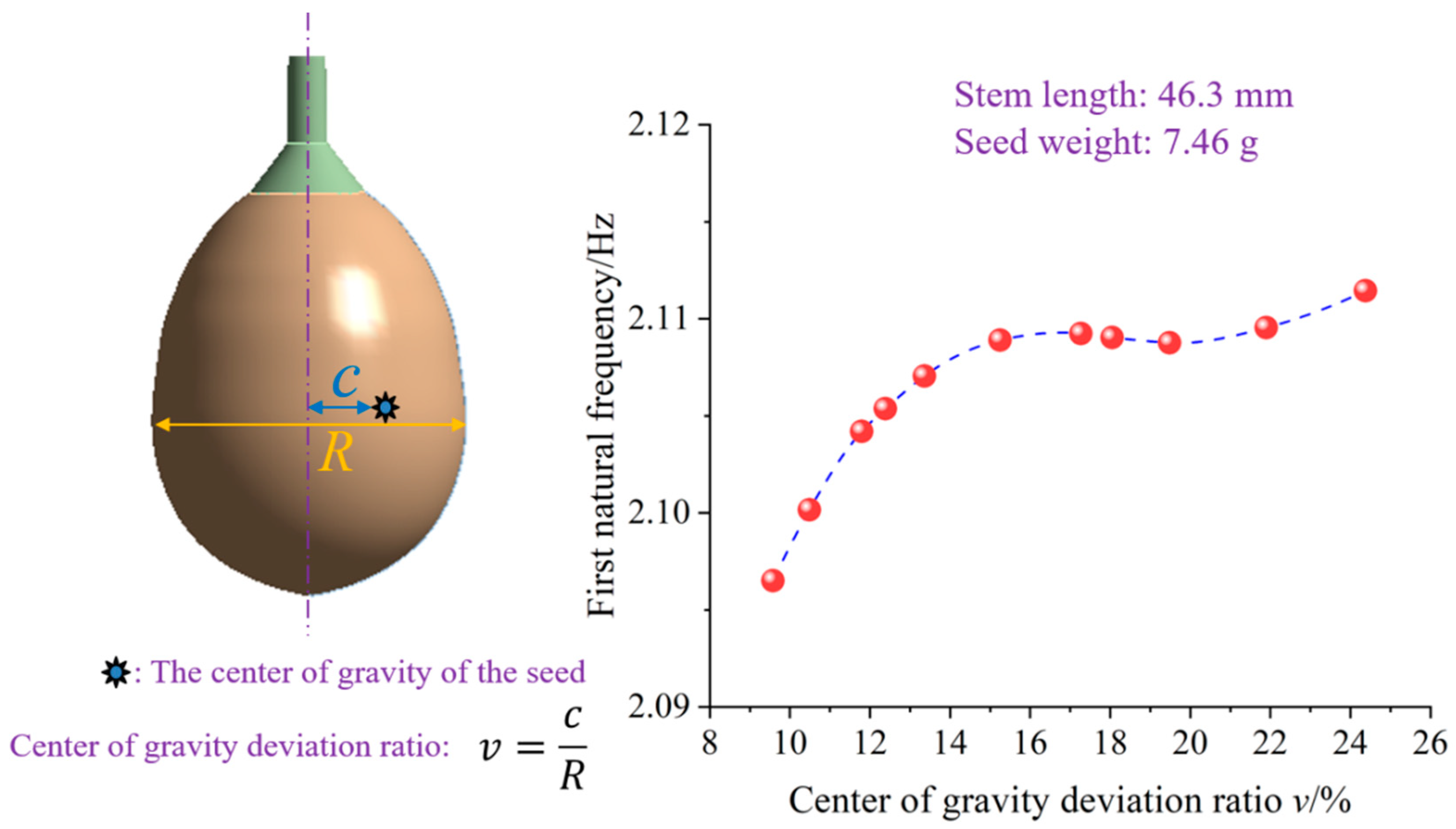
Disclaimer/Publisher’s Note: The statements, opinions and data contained in all publications are solely those of the individual author(s) and contributor(s) and not of MDPI and/or the editor(s). MDPI and/or the editor(s) disclaim responsibility for any injury to people or property resulting from any ideas, methods, instructions or products referred to in the content. |
© 2024 by the authors. Licensee MDPI, Basel, Switzerland. This article is an open access article distributed under the terms and conditions of the Creative Commons Attribution (CC BY) license (https://creativecommons.org/licenses/by/4.0/).
Share and Cite
Zhou, J.; Xu, L.; Zhou, H.; Zhang, R.; Jia, Z.; Zhang, F.; Zhang, Y.; Chen, J.; Zhang, C. Modal Variability of Ginkgo Seed–Stem System Based on Model Updating. Forests 2024, 15, 178. https://doi.org/10.3390/f15010178
Zhou J, Xu L, Zhou H, Zhang R, Jia Z, Zhang F, Zhang Y, Chen J, Zhang C. Modal Variability of Ginkgo Seed–Stem System Based on Model Updating. Forests. 2024; 15(1):178. https://doi.org/10.3390/f15010178
Chicago/Turabian StyleZhou, Jie, Linyun Xu, Hongping Zhou, Rongshan Zhang, Zhicheng Jia, Fubao Zhang, Yue Zhang, Juan Chen, and Cheng Zhang. 2024. "Modal Variability of Ginkgo Seed–Stem System Based on Model Updating" Forests 15, no. 1: 178. https://doi.org/10.3390/f15010178





